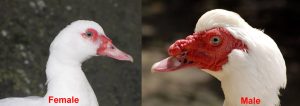The Muscovy Duck
Muscovy duck is the most common in Kenya and Africa in general. It is a unique duck with a bright red crest (called caruncles) around their eyes. Muscovy Ducks make a good broody and will often sit 3 or 4 times per year. It is the only domestic duck not to have descended from the Wild Mallard. It belongs to a sub group of perching ducks called “greater wood ducks”.
They are a large duck, with the males about 76 cm long, and weighing up to 7 kg. Females are considerably smaller, and only grow to 3 kg, roughly half the males’ size.
Muscovy and domestic ducks (such as the Pekin – which were developed from Mallards) are very different; Whereas a Pekin takes 28 days to hatch and a Muscovy takes 35 days, a mule or hinny takes 32 days to hatch.
They can be crossed but you get some very interesting results. If you cross a Muscovy male with a Pekin female you will hatch moulards (or mule ducks); if you cross a Pekin male with a Muscovy female the progeny are called hinnies.
Mules and hinnies cannot reproduce. Both males are sterile and only the hinny females lay eggs (though they cannot hatch). If you have Muscovy and Pekin together, the chances are poor that they will cross but if they do, a hinny will probably be the result as Pekin males can catch Muscovy females easier than Muscovy males can catch Pekin females.


